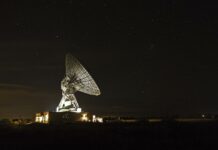Satellite communications innovator and space gateway Goonhilly Earth Station today opened a new green data centre designed to become a high performance computing hub for artificial intelligence (AI) and machine learning (ML).
The centre will use locally generated renewable power and an innovative cooling system where computers are kept cool by fully immersing them in liquid.
Goonhilly is one of the first organisations in the UK to deploy a liquid immersion cooling system from Submer to mitigate the power demands of high performance computing (HPC).
Goonhilly’s green platform is designed to meet the data-intensive needs of the automotive, life sciences and space/aerospace marketplaces. Plus its onsite array of solar panels can support the data centre’s full power requirements of 500KW, and local wind power will be added to the mix shortly.
Goonhilly’s goal is to create a UK hub for AI and ML services that acts as a marketplace and allows academia and enterprise to collaborate and share ideas.
The new managed platform delivers high performance GPU-based compute and storage for decentralised and centralised AI and ML applications to meet the data-intensive needs of the automotive, life sciences and space/aerospace marketplaces. By provisioning both compute and AI and machine learning resources on demand, customers can reduce the cost of deployment and accelerate time to market.
Further extending its AI capabilities, Goonhilly has joined the NVIDIA Inception programme for businesses that are transforming industries through advancements in AI and data sciences. Goonhilly will use the NVIDIA DGX-1, the world’s first supercomputer purpose-built for enterprise AI and deep learning.
Because Goonhilly’s tier 3/4 data centre sits at the junction of global subsea cables, satellite feeds and fibre, customers can analyse data at the edge, eliminating the cost of a leased line to send huge data volumes back to London, or farther afield, for processing.
Existing satellite customers are also expected to use the data centre. Previously, the data transmitted was solely small packets of communications signals but today’s satellites are used for applications including 8K real-time imaging, which use petabytes of data. By analysing the data at the edge, a much smaller packet can then be cost-effectively distributed.
To mark the data centre opening and as part of its celebrations of the 50th anniversary of the moon landing, Goonhilly is hosting an event on-site on Thursday 18th July 2019 for space industry partners, academia, customers and prospects. It includes a panel discussion on trends in AI, cloud and edge computing.
Zizo is one of the first data centre customers, having chosen to host its big data analytics as a service at Goonhilly. Peter Ruffley, Zizo’s chairman, commented, “When looking at data centres to host our cloud-based service, only Goonhilly could address our critical issues such as availability, resilience and affordability but also offer the value-add of green energy and immersive cooling. Customers are increasingly asking questions about the carbon footprint of compute power, which makes Goonhilly a great choice.”
Chris Roberts, head of data centre and cloud at Goonhilly, said: “There are people working on some clever algorithms to save our planet from climate change. The irony is that these models require heavy processing power. Fortunately new technology is helping, such as immersion cooling which is 45-50% more efficient than air cooling, cuts electricity demand in half, and also allows us to use the exhaust heat elsewhere.”








